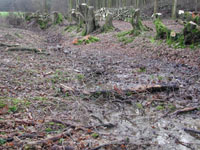The Ghost of Workers Past Part 2: Delving into the history hidden in your woodland

Identifying Features – banks and ditches
“I don’t think my wood has any archaeology in it,” somebody said to me recently. So, what are the chances of finding anything archaeological in your wood? And if you do, what is it likely to be? In all the woods I’ve looked at there has always been something archaeological, either in the trees, the ground flora or in the bumps on the ground. So the chances of finding archaeological features in your own woodland are very high. Wherever your wood is, there is a number of features which are more commonly found than others, and we’ll look at those first.
This is possibly the most common feature to be found either within the woodland or on the edge. If you’re not sure whether a slight rise in the ground is a bank or not, follow it. It may go nowhere, in which case it could be something else. If it does go somewhere then there’s a good chance it’s a bank. Does it go in a straight line, or is it wandering around? Does the bank have a matching ditch? The ditch may no longer look much like one. Over time it could have become pretty filled in. What with deer crossing it and rainfall over a century or more, there might not be much ditch left. It might well look like a slight dip in the ground on one side of the bank.
We’re now at the point where you either have a straight bank or a sinuous bank, and it either has the remains of a ditch or it doesn’t. Looking at each of these options –
Straight and no ditch – if the level of the ground on one side of the bank is higher than on the other, you could be looking at a lynchet. If this is the case the bank will be one-sided and th e bank will be where the ground level changes.
e bank will be where the ground level changes.
A lynchet was the edge of an arable field, often on sloping ground. People have ploughed up to the boundary and turned, and that together with the effect of rain-washed soil on a downhill slope has caused the soil to build up at the boundary. It would once have been marked by stones, trees or a hedge. There probably won’t be much of the original boundary markers to be seen, just the change in height. Lynchets are generally quite straight, but may be gently curved; they don’t tend to wiggle.
Straight and with a ditch – this would be somewhat unusual, but suggests a fairly recent boundary where a ditch has been dug, probably for drainage.
Sinuous without a ditch – the most likely explanation for this is as an internal wood boundary. In other words, there was woodland on both sides of the bank and the bank marked the boundary between two owners of woodland.
 Sinuous with a ditch – this suggests that the woodland has medieval origins, and the medieval wood was on the side of the bank opposite to the ditch. In those days woodland owners were responsible for keeping livestock out of their wood (unlike now where the farmer is responsible). With no barbed wire available, they had to construct something within their boundary that was animal proof. So they dug a ditch on the outside, throwing the spoil up to form a bank. Dig down one foot and throw the spoil onto a bank, and you’ve got a two-foot high barrier already. They also had to grow a hedge on the bank to act as a final deterrent. It was very effective as long as the ditch was kept dug, and the hedge was laid. It seems likely that in many places this barrier was maintained until early in the 20th century, but certainly after the First World War such practices tended to fall into abeyance. You may find stems of trees that have been laid over many years on such banks. If a ditch-with-bank runs through woodland it suggests that the side with the ditch had not been woodland at some time in the past.
Sinuous with a ditch – this suggests that the woodland has medieval origins, and the medieval wood was on the side of the bank opposite to the ditch. In those days woodland owners were responsible for keeping livestock out of their wood (unlike now where the farmer is responsible). With no barbed wire available, they had to construct something within their boundary that was animal proof. So they dug a ditch on the outside, throwing the spoil up to form a bank. Dig down one foot and throw the spoil onto a bank, and you’ve got a two-foot high barrier already. They also had to grow a hedge on the bank to act as a final deterrent. It was very effective as long as the ditch was kept dug, and the hedge was laid. It seems likely that in many places this barrier was maintained until early in the 20th century, but certainly after the First World War such practices tended to fall into abeyance. You may find stems of trees that have been laid over many years on such banks. If a ditch-with-bank runs through woodland it suggests that the side with the ditch had not been woodland at some time in the past.
You may realise from this that most ditches were not dug in order to drain water – in fact, many would have run parallel with the slope. But yours might be doing an excellent job of draining because it happens to run downhill. But if it’s a ditch without a bank, then it might have been dug for drainage only. But do look carefully to see if there are there mains of a bank somewhere along it, preferably with trees on it, because a lot of the bank could have been bulldozed out. It sometimes gets to the point when you really can’t be sure whether a farmer has re-dug a ditch recently or whether you’re looking at a historic feature.
We’ll have a look at recording banks and ditches next time.
 David Brown
David Brown
South East Woodland Archaeology Forum

Reproduced by kind permission of the Small Wood Owners Group
Comments are closed for this post.
Discussion
Hi Ian
Yes, David does express it all so well doesn’t he? He is very enthused.
Feel free to join our small woodland owners group while you search for yours!
Tracy
superb article found it great reading
im looking to buy from woodlands a small wood in norfolk so your article gave me much enthusiasm!!
nice one david!

Interesting article. I remember the course in woodland management I attended last spring where a woodland owner did show us remains of an internal boundary bank. Makes more sense now. Also, can’t wait to have another look at the ditches in my woods. One seems to have a bank on one side, one doesn’t. They run along two different edges of the wood. Perhaps they date from different periods? Anyway, thanks for that.
Jos
25 September, 2020